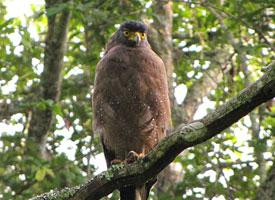
Weights and measures
| Length | from 60 to 70 cm |
|---|---|
| Weight | from 1,6 to 2,5 kg |
| Wingspan | 150 cm |
State of endangerment
| Endangered |
Animal description
The Egyptian vulture, scientifically known as Neophron percnopterus, is a fascinating and unique bird of prey that belongs to the Accipitridae family. This species is remarkable not only for its distinctive appearance but also for its wide range of behaviors and adaptations that have captivated the interest of ornithologists and bird enthusiasts around the world.Physical Description:
The Egyptian vulture is relatively small compared to other vultures, with a length ranging from 58 to 70 cm (23 to 28 inches) and a wingspan of 155 to 170 cm (61 to 67 inches). Adults are characterized by their predominantly white plumage, which contrasts sharply with their black flight feathers. One of the most striking features of the Egyptian vulture is its face, which is bare of feathers and exhibits a bright yellow to orange color, complemented by a distinctive black mask around the eyes. The bird's hooked beak is relatively slender and pale, with a yellow to orange hue matching the face. Juveniles and immature birds are distinguished by their darker, brownish plumage, which gradually lightens as they reach maturity over several years.
Habitat and Distribution:
The Egyptian vulture has a wide-ranging habitat that spans across southern Europe, northern Africa, the Middle East, and the Indian subcontinent. It prefers open landscapes such as arid plains, farmlands, and areas with sparse vegetation, where it can soar high in search of food. This vulture is a migratory bird, with populations in Europe and northern regions moving southward to Africa to escape the colder months.
Diet and Feeding Behavior:
This species is an opportunistic feeder with a varied diet that includes carrion, small mammals, birds, and reptiles. Interestingly, the Egyptian vulture is also known for its remarkable use of tools. It is one of the few bird species observed using rocks to break open eggs, showcasing an exceptional level of problem-solving ability. Additionally, it feeds on the eggs of other birds, employing a clever technique to break them open by hurling stones with its beak.
Reproduction:
Egyptian vultures are monogamous birds that form strong pair bonds. They typically nest on cliffs or in tall trees, where they build a platform of sticks lined with soft materials. The female usually lays one to three eggs, which both parents incubate for about 42 days. The chicks are altricial at birth, meaning they are born in a relatively undeveloped state and require significant parental care. Both parents are involved in feeding and protecting the nestlings until they fledge around 90 days after hatching.
Conservation Status:
The IUCN Red List classifies the Egyptian vulture as Endangered. The species faces several threats, including habitat loss, poisoning from agricultural pesticides, and direct persecution. Additionally, the use of veterinary drugs in livestock, which can be toxic to vultures feeding on carcasses, poses a significant risk. Conservation efforts are underway in various parts of its range to protect this unique bird, including habitat protection, anti-poisoning campaigns, and education programs aimed at reducing human-vulture conflicts.
In summary, the Egyptian vulture is a remarkable bird of prey with unique physical characteristics, fascinating behaviors, and a wide-ranging habitat. Despite facing significant conservation challenges, ongoing efforts aim to secure a future for this species in the wild.
Similar Animals
New photos of animals
Top 10 animals
- Dolphin gull (Leucophaeus scoresbii)
- Diana monkey (Cercopithecus diana)
- Moustached guenon (Cercopithecus cephus)
- Galápagos tortoise (Geochelone nigra complex)
- Stone loach (Barbatula barbatula)
- Japanese macaque (Macaca fuscata)
- Greek tortoise (Testudo graeca)
- Russian tortoise (Testudo horsfieldii)
- Common flying dragon (Draco volans)
- Galápagos penguin (Spheniscus mendiculus)


